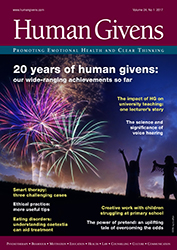Come fly with me (calmly)
Sian Withers shows how she makes very good use of the human givens approach thousands of feet up in the air.
On one memorable flight to Cape Town, passengers and crew spent a horrendous five hours cooped up in the aircraft before we could even take off from Heathrow. It was inevitable that people would be feeling, frustrated, bored and irritated in that time but a couple of people were clearly more troubled than most.
One was a grey-haired gentleman who appeared to be steaming with fury. He was extremely rude to one of my colleagues and then turned to me and hissed loudly, “Keep HIM away from me or I won’t be responsible for what I do!” Meanwhile another man, in a bright canary-yellow shirt, was strutting up and down the aircraft non-stop, looking extremely agitated. It was clear that the three cabin crew in first-class that day, of whom I was one, had at least two ‘situations’ to manage simultaneously, alongside serving champagne and juices, distributing newspapers and wash bags, and hanging jackets in wardrobes.
Cabin crew for our airline, one of the world’s leaders, are trained to a commendable standard for dealing with most eventualities that could possibly transpire on commercial aircraft during flights to all corners of the globe. We have sound safety and evacuation procedures and our drills for this and for turbulence, smoke or fire, medical incidents and emergencies, hijack and other security infringements are finely honed. We also, of course, serve food, drinks and duty-free goods and provide excellent customer service throughout a flight. As part of our latter role, we might well find ourselves calming a screaming toddler, a stressed mother, handling drunken behaviour that potentially compromises the safety of the aircraft, and coping with a hypoxic passenger, childbirth, sexual harassment, heart attacks, frayed tempers, claustrophobia, verbal abuse, fear of flying, anxiety attacks, food issues, rudeness, couples making out in the cabin or the loos, and plenty more besides.

It is in coping with these very human dilemmas that I particularly value the skills, techniques and understandings that I acquired during my Human Givens Diploma training. Being a part of a 12,000-strong cabin-crew team but working with a completely different team of crew (of up to 16 people) on every flight we take necessitates all of us to create, and remain in, strong rapport with each other throughout the flight. We also need to keep rapport with customers at all times as, when there are so many people in such close proximity flying thousands of feet above the ground, it is imperative that problems are handled quickly and effectively. During my time as a stewardess I have come across people of many different cultures, races and religions whilst working up in the clouds but one thing that I have come to realise is that we all have the same needs and wants, aspirations and shortfalls, and taking a very human approach is the best way to deal with everything.
“My wife has Alzheimer’s”
I went up to where the grey-haired man was sitting with his wife and asked if everything was okay. “No!” he shouted. “My wife has Alzheimer’s and this has all been very stressful for her!” As I expressed concern and encouraged him to talk, it emerged that his wife, already confused about where she was, had felt even more stressed and upset when airport security staff checking belongings (who did not know that she had Alzheimer’s disease) had seemed a little brisk. This had so upset her husband that he was in an angry state before he even boarded the aircraft. I quickly explained the situation to my colleague, assuring him that the attack on him had not been personal, and then we pulled together as a team; we both listened and I helped as much as I could to alleviate the stress of the gentleman, who was both concerned and embarrassed about his wife.
Simply by spending a little time paying attention to her and engaging her in conversation about topics familiar and important to her, I was able to ensure that she started to feel safe again. I asked about her family and showed interest in her stories about her son and new grandson. Her husband eventually joined in the conversation and I discovered that they had planned for a whole year for this trip to see friends in South Africa but that travelling was becoming increasingly stressful for them because of the wife’s condition. I assured them that, if they had a problem or needed any help during the flight, I would do my utmost to help them. (Indeed, the husband asked if I could wait outside the toilet while his wife used it, as she could easily become disoriented, and I did so.) Because the husband’s anger was appropriately managed, he was able to become rational again. Later, he apologised to my colleague, saying that he didn’t know what had come over him. He thanked us both profusely for our care and understanding towards his wife. Calm and comfortable, they had a good flight.
The man in the canary-yellow shirt

Meanwhile Maurice, the agitated man in the canary-yellow shirt, had decided, hours into our delay on the ground, that he wanted to get off the aircraft. This was not a realistic option because, as a result of the additional time it would take to locate and remove his luggage, the flight would have to be further postponed and then completely re-crewed, as, in that eventuality and including the flight time, the existing crew would exceed the maximum time that they could legally spend on duty. Clearly, careful dialogue was called for. I quickly found out that Maurice had not flown for 20 years and was claustrophobic. I asked him, “Do you recall any time in your past when you had a feeling similar to this?” He instantly told me that, when he was five, he had been locked in a cupboard by his stepfather, yet it was a complete light-bulb moment for him when I suggested the connection between this incident and his claustrophobia.
Of course, what Maurice really needed was the rewind detraumatisation technique but it wasn’t a suitable time or place to carry it out (although I did firmly suggest that he see a human givens therapist for this treatment when he got home). Instead, I kept him talking and showed him how to breathe in order to lower his anxiety. I explained to him that, if we make our out-breaths longer than our in-breaths, we tap into the body’s natural relaxation response and so we automatically start to relax and feel calmer. I could see that he understood and I watched to make sure that he was doing the breathing correctly. I told him, once he was calm, “If you start to feel anxious again at any time, you can do this relaxed breathing and you will feel calm.”
This was all a revelation to him and later he declared that his first-class seat, on which he had spent thousands of pounds, had more than paid for itself. He was very grateful. On arrival in Cape Town, as he waited to disembark from the aircraft, he stood near me at the door and I took the opportunity to remind him that, on his flight home to the UK, “if you have any of the old angst about flying that you had yesterday, you can handle it easily, just as you did before we took off out of London. You are in charge!”
Turbulence
We often get passengers who are very frightened of turbulence. On one occasion, an hour from arriving in New York, we hit quite a bad patch, sufficient for the passengers to be requested to remain strapped in but not bad enough for the crew to have to strap in too. I was again in the first-class cabin and saw that one lady was extremely distressed. I knelt beside her, made eye contact and quickly discovered that she had had a bad experience with much worse turbulence the previous year, when she had had her eight-year-old granddaughter with her. She was pattern matching to the event and was nauseous, rigid and breathing high up in her chest. I started a conversation with her, asking questions about her grandchild, whether she herself lived in New York and where she was from originally – unfortunately, her English was poor, which made things a bit harder. So I paid especial attention to conveying my concern through a warm tone of voice. When I was in absolute rapport with her and I felt that she connected with and trusted me, I suggested that she watch how I was breathing and helped her to copy it and calm down. I also helped her access her resources by complimenting her on coping with a much more difficult situation previously and keeping her concern from her granddaughter. I also tried to uncouple the pattern match by pointing out the ways in which this situation differed from the last one. Once again, I used some suggestive language and post-hypnotic suggestions to help her cope with fear another time.
The tired twins

Because of my human givens training, I am highly aware of the importance of ensuring that everyone gets their needs met. For instance, on one occasion, two tired toddler twins were crying simultaneously and their clearly frazzled young mother was becoming irritable. Picking up on her impatience, the twins were fast approaching tantrum point. I quickly re-focused their attention by distracting them with some plastic cups, which I made up a story about. Then, seeing that they had a picture book version of “Old MacDonald had a farm”, I quickly read and sang through it with them, encouraging them to make the animal noises. They laughed, smiled, calmed down and one started to yawn, so I sang them a soothing Welsh lullaby. The mother visibly relaxed and, after her short ‘time out’, was able to cope again.
No more whisky
We have quite a few instances of passengers drinking too much alcohol whilst aboard. This usually happens because they have a fear of flying and are trying to calm themselves down. We, the crew, monitor such people closely and liaise over whether or not to stop serving alcohol to someone beginning to behave oddly. On one such occasion, when a colleague on a flight from Hong Kong to Heathrow refused a man more whisky, he overreacted and aggressively followed her into the galley. She felt intimidated. I could see that things might escalate, so I quickly got into rapport with him by asking him if he liked whisky. That got a “yes”, of course. Next, I asked a question about Hong Kong which was guaranteed another yes. And then I said, “Am I right that you are unhappy about not having another whisky?” He had to agree with me again. I was smiling as this conversation progressed and matching his body position and movements.
Through asking questions I found that not only was he terrified of flying, but also that he was on his way back to England because his dad was critically ill in hospital there, and he was extremely worried about him. We spoke about his family and how he was planning to drive his car to the hospital once he reached London. I pointed out that he would be okay to drive if he stopped drinking now, as the alcohol would be out of his system, and that he would also have a clear head and thus be able to be there fully for his dad and the rest of his family when he arrived at the hospital. Tears welled in his eyes. By this stage we were sitting side by side on the crew seat at the door to the galley, away from the 120 or so other passengers at the back of the aircraft. He told me that he felt I had really understood and thanked me for listening. His breathing had calmed and I took the opportunity to point this out to him and to show him how to calm down his breathing in future. He went back to his seat and did not ask for any more alcohol for the rest of the flight.

Obsessive cleaning
I have found my human givens understandings useful with colleagues, too, and not only as a means to generate rapport quickly. Once, when I was working in business class on the upper deck of a Jumbo 747, I noticed another stewardess meticulously wiping surfaces in the galley kitchen rather more often than necessary. When she saw me looking, she mentioned in a jokey, dismissive way that she must have obsessive-compulsive disorder (OCD), but clearly it bothered her. We got talking and it emerged that she had quite a few stresses at home to deal with and that she had got into the habit of cleaning in a rather obsessional way, to reduce her anxieties about something bad happening. Cleaning had calmed her at first, because it made her feel closer to her two sisters (who lived abroad and whom she missed very much) – all three, as teenagers, had had to take turns to clean the house. I suggested that the compulsion to clean had turned into a bit of a bully and told her that it would help if she labelled the OCD as something like that, separate from herself, which she could decide to stand up to and say ‘no’ to. I also advised her to try to become aware when her stress levels were creeping up and then to do something pleasant to distract and relax herself, as well as trying to work out some practical solutions to her problems. We keep in touch by email and last week she emailed to say that the OCD had gone completely.
Calming influence
It is hard to do all that I would like to do to help, when working on a busy aircraft with many simultaneous demands being made on me. However, the human givens approach has provided me with many valuable skills, strategies and tools that I can quickly put into practice, and the RIGAAR™ model (rapport building, information gathering, goal setting, accessing resources, agreeing strategies and rehearsing success) has given me a strong framework for being the most effective I can be and to serve my fellow humans well. Having a clear understanding of how the mind works and keeping in mind that, if a problem presents itself on the aircraft, it is about a need not being met is extremely helpful. Listening and then identifying that unmet need makes it far easier to find a solution to a problem situation. Every few months, the crew member who is heading the team on that particular day has to write an assessment of the other team members. Naturally, the report is written by a different person each time, as we never work with the same set of people. I have been fascinated to find that every report written about me always contains the word ‘calm’ or comments that I am a ‘calming influence’ to have around. This is a great validation of the approach that I take.
Taking it all to school
My work on the airline is not the only setting in which I have made good use of my human givens training. I work one month on, one month off, as a member of cabin crew and, in my month off, I am a supply teacher in different primary schools. I have on many occasions calmed an over-lively class with a simple breathing relaxation and routinely do visualisations with them – particularly popular is one about finding some kind of treasure on a beach. To one extremely bright but very lonely little girl, who never had anyone to play with, I told the story of the Ugly Duckling and also used the ‘my friend John’ technique to tell her of another lonely little girl of her age, who used to have an imaginary wonderland and an imaginary friend. I suggested to her that, in the playground, she should smile and enjoy playing with an imaginary friend of her own: “Do this and very soon other children will want to join in your fun.” During the lunch break, I saw her happily playing with two other little girls, the three of them smiling, holding hands and jumping across what looked like imaginary stepping stones …
Sian Withers has worked as cabin crew for an airline for the last 18 years. Before that she trained and worked as a primary school teacher and, in her ‘off’ time from flying, does supply teaching in local primary schools. She holds the Human Givens Diploma.
This article first appeared in"Human Givens Journal" Volume 18 - No. 4: 2011
 Spread the word – each issue of the Journal is jam-packed with thought-provoking articles, interviews, case histories, news, research findings, book reviews and more. The journal takes no advertising at all, in order to maintain its editorial independence.
Spread the word – each issue of the Journal is jam-packed with thought-provoking articles, interviews, case histories, news, research findings, book reviews and more. The journal takes no advertising at all, in order to maintain its editorial independence.
To survive, however, it needs new readers and subscribers – if you find the articles, case histories and interviews on this website helpful, and would like to support the human givens approach – please take out a subscription or buy a back issue today.
Latest Tweets:
Tweets by humangivensLatest News:
HG practitioner participates in global congress
HG practitioner Felicity Jaffrey, who lives and works in Egypt, received the extraordinary honour of being invited to speak at Egypt’s hugely prestigious Global Congress on Population, Health and Human Development (PHDC24) in Cairo in October.
SCoPEd - latest update
The six SCoPEd partners have published their latest update on the important work currently underway with regards to the SCoPEd framework implementation, governance and impact assessment.
Date posted: 14/02/2024














